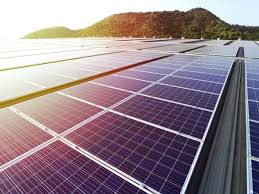Renewable Energy
is energy that is collected or generated from renewable resources. Sources such as sunlight, wind, water and waste are naturally replenished. Renewable energy is key to mitigating the harmful effects of climate change, as renewable energy sources don’t emit carbon and other greenhouse gases that contribute to global warming,
Renewable energy is generally considered ‘clean’ or ‘green’ energy, particularly when technologies encompass other low or zero emission resources such as energy efficiency.
Solar photovoltaics (PV), Wind Turbines, Biomass Boilers, Air and Ground Source heat pumps are among the most popular renewables available today. Many businesses now engage at least one of these technologies, and sometimes several in conjunction with each other to facilitate 24/7 generation.
Solar PV
Solar power works simply by converting light from the sun in to electricity. The electricity generated through the solar panels can then be used to power your home or business. An inverter is necessary to convert the direct current (DC) to alternating current (AC) electricity – the same as the electricity supplied by the grid. Solar PV is now a very cost efficient way to generate power whilst reducing carbon emissions.
Battery Storage
Batteries are becoming a more feasible option, with energy prices rising and battery prices falling. A battery stores the energy produced by the Solar PV so that it can be used when required, even when the solar panels aren’t generating. This enables 24 hour generation from your own power generation, reducing the requirement for electricity supplied by the grid.
Wind Generation
Wind energy and wind power are terms that describe processes by which the wind is used to generate electricity or mechanical power. A wind turbine turns wind energy in to electricity using an aerodynamic force from the rotor blades. The blades of a wind turbine work in a similar way to a helicopter rotor blade or an airplane wing.
Wind turbines can be based off shore, on shore or even on buildings, making them a potential option for some businesses depending on the wind speed factor and location.
Air Source Heat Pumps
Air source heat pumps (ASHPs) absorb heat from the outside air enabling you to heat your business and hot water. They have the ability to still extract heat when air temperatures are as low as -15 degrees. With Renewable Heat Incentives (RHIs) still available in some areas, air source heat pumps are a popular choice when it comes to reducing heating bills and reliance on fossil fuels.
Ground Source Heat Pumps
Ground source heat pumps (GSHPs) work in similar way to air source heat pumps except they extract heat from the ground rather than the air. Pipes buried in the ground heat which is then absorbed in to a mixture of water and antifreeze around a loop of pipe called a ground loop. The heat is then passed through a heat exchanger in to the heat pump. Ground source heat pumps are a particularly popular option with new builds or where renovation works are taking place. Renewable heat incentives may also be available to help subsidise your project and reduce the payback time.
Biomass Boilers
A biomass boiler works in a similar way to a conventional boiler. Fuel (sustainably sourced) is combusted to produce heat which is then used to heat water. A hopper can be used to store large volumes of wood pellets so that the boiler infrequently need to be refuelled. Renewable heat incentives are currently still available for Biomass Boilers too.
If you’re considering renewable technologies for your business and wondering which technology might work best – The Energy Consultant can advise you on the most suitable option to meet your targets. For a simple and objective analysis and to find out your possible returns, please contact one of the team.


